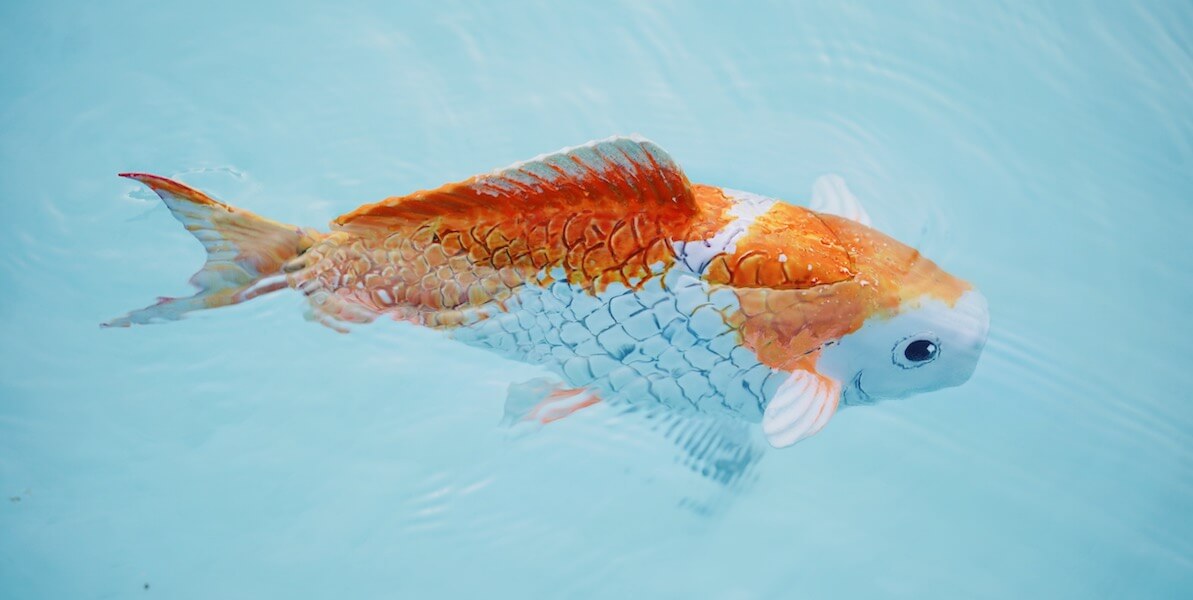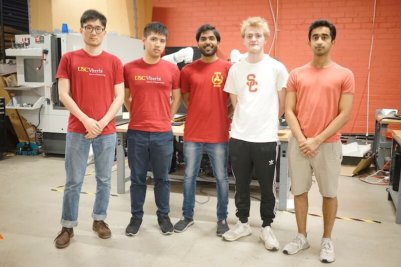
Meet SCI-FI BOT, the robotic fish created by two teams of AME students to mimic the look and appearance of a Sarasa Comet Goldfish. PHOTO/YULIN YU
When humans first conceived of robots, they were clunky, made of sheets of aluminum and steel that prevented them from moving fluidly. Even from a distance, there was no chance of mistaking a robot for a human—or any other type of living creature.
Using computer-aided design (CAD) modeling, a team of student engineers, working with Dr. Satyandra K. Gupta, Smith International Professor in Mechanical Engineering and associate chair of the Department of Aerospace and Mechanical Engineering, strove to advance applications of robotics by creating a soft robotic fish who, from a distance, would be mistaken for a real one.
The fish, named SCI-FI BOT (Sarasa Comet Inspired Fish Robot), was modeled after the Sarasa Comet Goldfish. “It’s a super common fish, especially in America. It will make it easier to study the fish and its motions, and make it as realistic as possible,” said Mishaal Parekh, a USC Viterbi sophomore.
That reality was achieved step by step for less than $200, through the hard work of two groups of graduate and undergraduate mechanical engineering students. Launched in the summer of 2018 with an initial team of two students—Aniruddha Shembekar and Rohil Aggarwal—who gave the fish its rudimentary elements, the fish gained its intuitive, realistic movement and look through the work of a second team, over the past semester. The second team included Manish Shastrakar, Yilun Yu, ChienTzai Chen, Mishaal Parekh, and Jonathan Wilson.
“Many have attempted to create robotic fish before, but if you look at the capabilities of an actual fish, robotic versions are not very capable at all. The main goal of this project was to integrate elements like a camera, while ensuring the fish had a flexible, realistic outer body and mimicked the actual movement of a Sarasa Comet Goldfish,” said Manish Shastrakar, a second year master’s student and team lead.
Appearance
SCI-FI BOT didn’t acquire its good looks easily. The process began with research into materials that would emulate the capabilities of real fish skin. The team contacted 3D printers, however, were unable to find a solution that was cost-effective in printing skins that could integrate color and texture seamlessly. Turning to plan B, the team used molds that they filled with silicone—which is flexible and stretchable—to create the fish’s outer body. They later enhanced this “skin” with paint to replicate the color and scales expected in a Sarasa Comet Goldfish.
Motion
How do you get a robot to move like a real fish? You study the real version from every angle, in different environments, which is exactly what this team did. While fish employ several different types of locomotion, the student team chose to focus on the sub-carangiform. This means, as the tail moves, you will see motion all the way through to the fish’s head. Usually, this indicates the fish’s body is stiffer, giving the fish speed while control over maneuvers, like turns, are reduced. From a design perspective, this perfectly aligned to the stiffer pieces of the body, which were 3D printed. It also meant that a fewer number of servo motors—motors coupled with sensors to allow for precise control of positioning—were required to mimic this type of motion in the model.
To perfect SCI-FI BOT’s motion, the team measured the angle of its body parts to its own longitudinal axis when the fish was in motion. Servo motors were placed at each of these points of rotation.
Seeking Challenges
With a desire to gain practical experience in robotics, a field which offers continual growth and exciting professional opportunities, students sought out Gupta, Director for the Center for Advanced Manufacturing (CAM) (where students built the fish), for a project that would engage and challenge them.
“Making a fish is not an easy task, because you have to be specific about the motion and the shape and deal with space constraints,” said Yulin Yu, a second year master’s student. “A robotic fish, in particular, provides the opportunity to overcome challenges ranging from software design to electrical circuits to mechanical design to aesthetics. All of this plus the fish has to work under water.”
The SCI-FI BOT team met many of these challenges, extending battery life from the previous iterations by double (now one hour) and making sure charging could occur wirelessly. Next up: working on depth control and giving the fish autonomy—the ability to make it from point A to B on its own.
In the meantime, students also learned valuable lessons about working in the trenches. “What I learned was to be a jack of all trades. From contacting vendors for the fish skin to creating the CAD model to editing the video of our work,” said Parekh.

Meet the team behind the SCI-FI BOT: (from left to right) Yilun Yu, ChienTzai Chen, Manish Shastrakar, Jonathan Wilson, and Mishaal Parekh. (Not pictured: Aniruddha Shembekar and Rohil Aggarwal from the Summer 2018 team.) PHOTO/ YILUN YU
Underwater Insights
Soft robots are a growing field, as they are viewed to be safer and easier to maneuver than hard robots. At the same time, soft robots have a closer likeness to human and animal bodies, allowing them to more easily blend in.
A robotic fish, in particular, could be used to study marine life. Biologists, who have in the past been limited by tools that disturb marine life with their presence, will be better able to see, up close, how fish behave and communicate with each other using robots like SCI-FI BOT.
“It’s unobtrusive, so it’s easier to get a natural look at what is going on in the ocean,” said Parekh.
Beyond that, what we learn could help us in improving how we ourselves navigate bodies of water.
“From a research perspective, the more closely you can replicate the fish, the better we can learn about how fish swim—gaining understanding of their efficiencies. How do they conserve energy or deal with the current? We can use this to help us design underwater vehicles,” said Gupta.
For now, SCI-FI BOT continues practicing laps at the surface.
Published on May 15th, 2019
Last updated on October 18th, 2024







